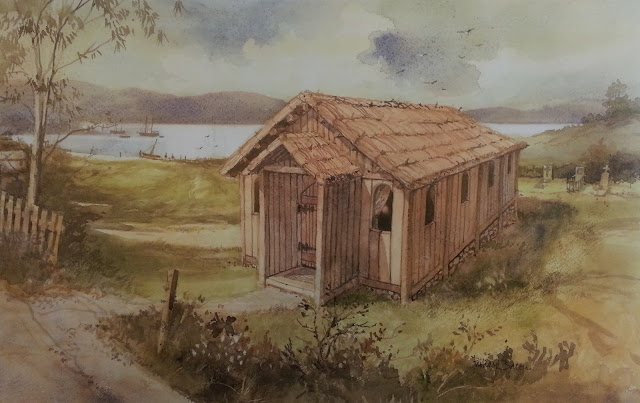No. 877 - Hobart's Burial Ground Chapel c.1810-1812
Hobart’s first church service took place in 1804 on a spot where the Town Hall now stands. The service was led by Reverend Robert Knopwood and it is regarded as the first formal Christian services at the settlement. Later services were held in a carpenter’s shop which had a thatched roof, earth floor and wooden slabs for seats.
One of Knopwood’s first duties was to establish a burial ground. Together with Lieutenant- Colonel David Collins, he marked out a burial site which is now St David’s Park. It was here that the first church, a basic wooden structure was built in 1810. The site of the building was near the east end of St David’s Park. It was built alongside Collins’ grave following his death in March 1810. The church was never consecrated.
The chapel existed for only a short time as it was blown down in a storm in 1812 and was not replaced until the construction of St David’s began in 1817. In the meantime services were held on the parade ground and on the verandah of Hobart’s first Government House as well as at the prison and the barracks.
No description of Tasmania’s first church exists however artist Richard Bacon’s representation of it can be considered fairly accurate. Bacon’s painting has been superimposed on a photograph of St David’s Park close to Collin’s memorial, which was erected by Lieutenant-Governor Sir John Franklin in 1838.
As Hobart developed the land surrounding the burial ground was built on and by the mid-19th century concerns arose about the health risk of a having a burial ground in densely populated area. In 1865 the Government passed the Cemeteries Act paving the way for the development of the Cornelian Bay cemetery in 1872. St Davids cemetery and other burial grounds within the city limits were closed. After the cemetery’s closure to further burials it became badly neglected and deteriorated to scandalous state. At a protest meeting held in 1919 local businessman Alfred Courtney-Pratt recalled that:
“One of his earliest recollections was being taken to the cemetery by his father to see the grave of a female relative. The ground had been allowed to fall into a shocking condition, and he had even seen children collecting bones there, placing them in a bag, and selling them for old bones”.
In In 1925 the burial ground was finally converted into a public park. Some human remains were reinterred at Cornelian Bay and a number of headstones were salvaged and displayed in a section of the the park. Although many of the headstones were destroyed, human remains still lie under the lawns and gardens of the park.

Richard Bacon's visualisation of Tasmania's first church. Source: http://saintdavids.org.au

St David's Cemetery "Clearing a cemetery for a recreation park" source: Tasmanian Archives
http://saintdavids.org.au/past-present/history/historic-images/the-first-st-davids/
Dwight, Alan, Tasmanian Anglican, Two Hundred Years of Anglican Worship in Tasmania, March 2004
Henslowe, Dorothea I & Hurburgh, Isa Our heritage of Anglican churches in Tasmania. Mercury-Walch, Moonah, Tas, 1978.
One of Knopwood’s first duties was to establish a burial ground. Together with Lieutenant- Colonel David Collins, he marked out a burial site which is now St David’s Park. It was here that the first church, a basic wooden structure was built in 1810. The site of the building was near the east end of St David’s Park. It was built alongside Collins’ grave following his death in March 1810. The church was never consecrated.
The chapel existed for only a short time as it was blown down in a storm in 1812 and was not replaced until the construction of St David’s began in 1817. In the meantime services were held on the parade ground and on the verandah of Hobart’s first Government House as well as at the prison and the barracks.
No description of Tasmania’s first church exists however artist Richard Bacon’s representation of it can be considered fairly accurate. Bacon’s painting has been superimposed on a photograph of St David’s Park close to Collin’s memorial, which was erected by Lieutenant-Governor Sir John Franklin in 1838.
As Hobart developed the land surrounding the burial ground was built on and by the mid-19th century concerns arose about the health risk of a having a burial ground in densely populated area. In 1865 the Government passed the Cemeteries Act paving the way for the development of the Cornelian Bay cemetery in 1872. St Davids cemetery and other burial grounds within the city limits were closed. After the cemetery’s closure to further burials it became badly neglected and deteriorated to scandalous state. At a protest meeting held in 1919 local businessman Alfred Courtney-Pratt recalled that:
“One of his earliest recollections was being taken to the cemetery by his father to see the grave of a female relative. The ground had been allowed to fall into a shocking condition, and he had even seen children collecting bones there, placing them in a bag, and selling them for old bones”.
In In 1925 the burial ground was finally converted into a public park. Some human remains were reinterred at Cornelian Bay and a number of headstones were salvaged and displayed in a section of the the park. Although many of the headstones were destroyed, human remains still lie under the lawns and gardens of the park.

Richard Bacon's visualisation of Tasmania's first church. Source: http://saintdavids.org.au

St David's Cemetery "Clearing a cemetery for a recreation park" source: Tasmanian Archives
and Heritage Office: Allport Library & Museum of Fine Arts

Source: http://saintdavids.org.au - reproduced under NonCommercial-ShareAlike 4.0

Source: http://saintdavids.org.au - reproduced under NonCommercial-ShareAlike 4.0
Sources:
World,
Tuesday 4 March 1919, page 6.http://saintdavids.org.au/past-present/history/historic-images/the-first-st-davids/
Dwight, Alan, Tasmanian Anglican, Two Hundred Years of Anglican Worship in Tasmania, March 2004
Henslowe, Dorothea I & Hurburgh, Isa Our heritage of Anglican churches in Tasmania. Mercury-Walch, Moonah, Tas, 1978.




Comments
Post a Comment